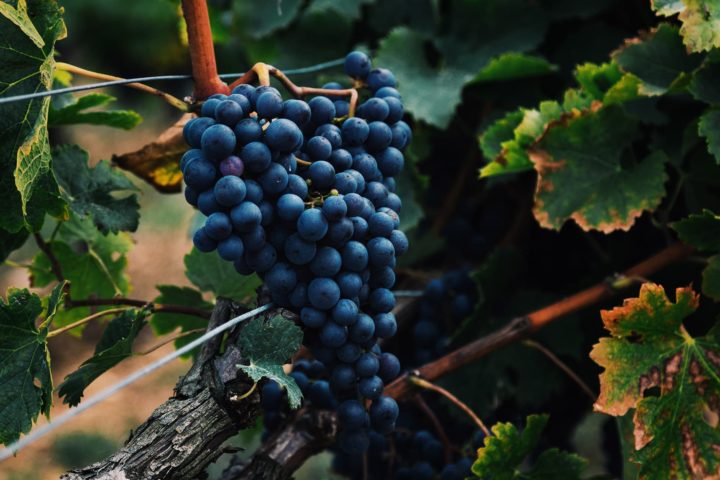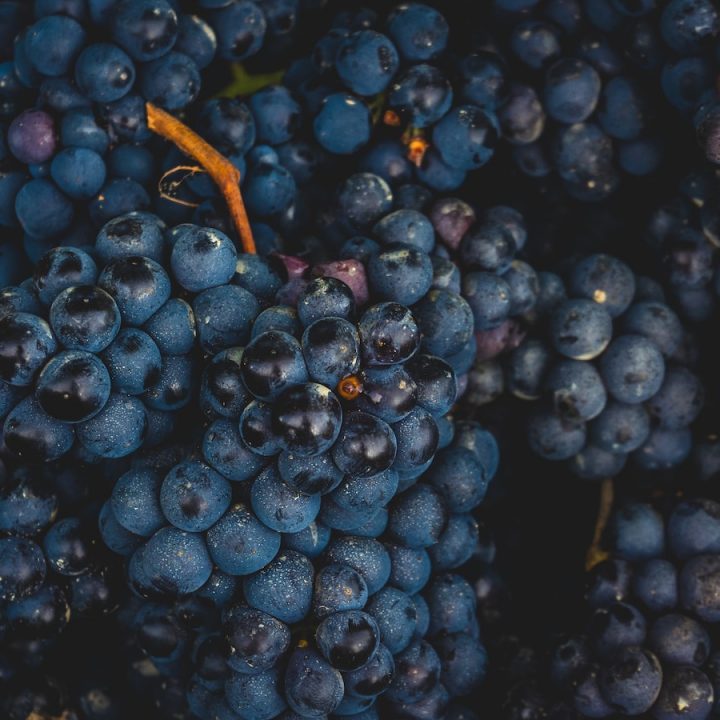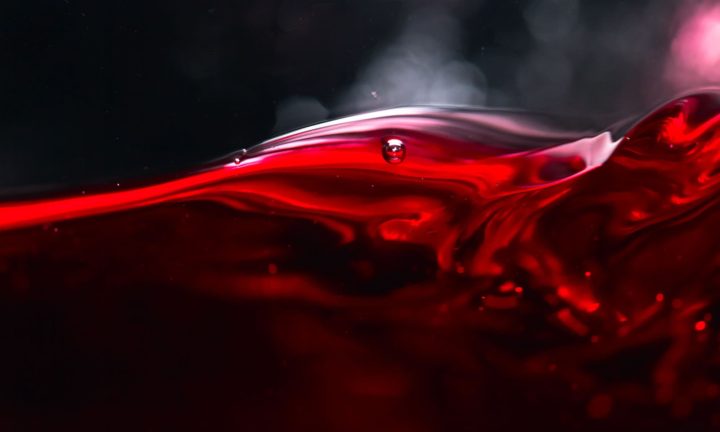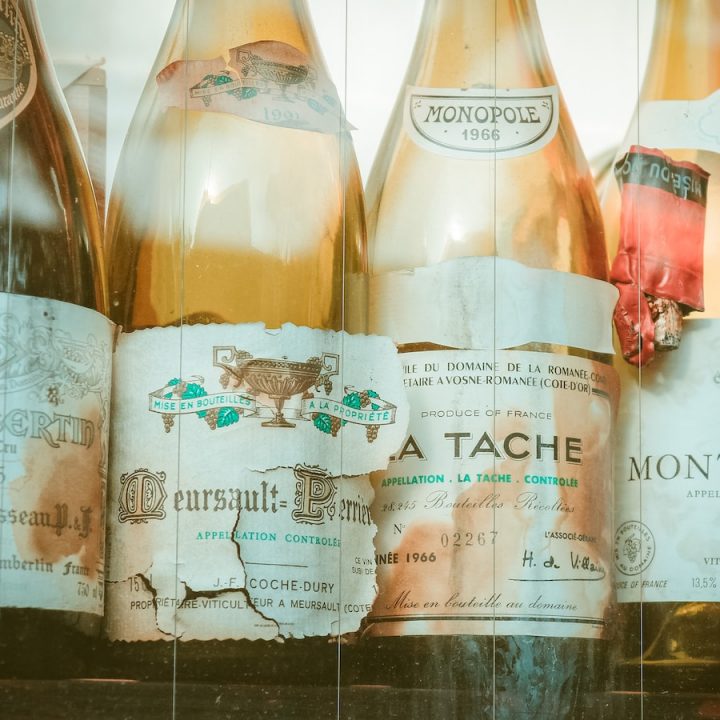Decanting – a technique that has been associated with wine for centuries. As a wine lover, you are certainly familiar with the term decanting, but what exactly does it mean and why is it so important anyway?
In this post, we’ll explain why and how you should decant wines, what the difference is between decanting and decanting, and give you step-by-step instructions for both methods. In addition, we dispel some myths about decanting and explain which types of wine you decant best and when.
What is decanting and caraffing and what is it used for?
Decanting refers to the process of transferring wine from its original bottle into another container, usually a decanter. This process serves two main purposes. First, the wine is separated from the deposit that has settled over time. Although this sediment is completely harmless, it can cause a sandy mouthfeel as well as a bitter taste. By decanting, you ensure that the wine does not contain any unwanted residue.
The second purpose of decanting is to aerate the wine. This process, also known as decanting, creates a smooth impression and enriches the wine aromas and flavors. Especially young wines with a lot of tannin benefit from aeration, as it makes them softer and less bitter. The result is a smoother and more pleasant drinking experience.
Decanting or caraffing: What is the difference?
Caraffing and decanting are two different methods to improve the aroma and taste of a wine. The first is about contact with oxygen to improve the overall picture. In this process, the wine is intentionally oxygenated so that it quickly develops an intense bouquet and a good mouthfeel. “Letting it breathe” is usually applied to younger red wines, especially big, bold, tannic reds, but some whites can also benefit from a little oxygen contact.
Decanting, on the other hand, is about pouring pure wine or rather separating the wine from its deposit. This removes sediments that have settled at the bottom of the bottle during storage. If you drink them along, they can disturb the taste and structure of the wine. In this process, the wine is treated much more gently than in caraffing, since micro-oxidation is usually not desired. Decanting is typically done with older drops that are sensitive to oxygen.
The main difference with decanting is that in decanting the wine comes into more intense contact with oxygen to develop its aromas and flavors as quickly as possible, while in decanting the sediments are separated from the wine to allow it to breathe and open up before serving. Aeration is mainly used for young red wines, while decantation is used for older and more delicate red wines. Both processes are intended to improve the flavor and olfactory character of the wine, but the choice depends on the type of wine and the desired result.
Preis inkl. MwSt., ggf. zzgl. Versandkosten / Letzte Aktualisierung am 2025-07-09 / Affiliate Links / Bildquelle: Amazon Product Advertising API
The advantages of decanting wine
Improved aroma and taste
One of the main reasons why wines are decanted is to improve their aroma and flavor quality. Aeration causes the wine to “breathe” and thus lose volatile compounds that can cause unpleasant odors or tastes. It also helps to open up and develop the wine’s subtle and complex aromas, resulting in an enhanced tasting experience.
Softer texture
Decanting wine also provides improved texture. The tannins naturally present in the skins, seeds and stems of the grapes give the wine an astringent or bitter taste. By exposing the wine to air, the tannins become softer and less coarse, giving it a more pleasant mouthfeel.
Improved optics
Decanting can also significantly improve the appearance of the wine. The deposits in the bottle cause the wine to appear cloudy or dull. By carefully decanting the wine, you ensure that it appears clear and visually appealing when served. In addition, a beautiful decanter is an impressive eye-catcher at any dinner party or wine tasting.
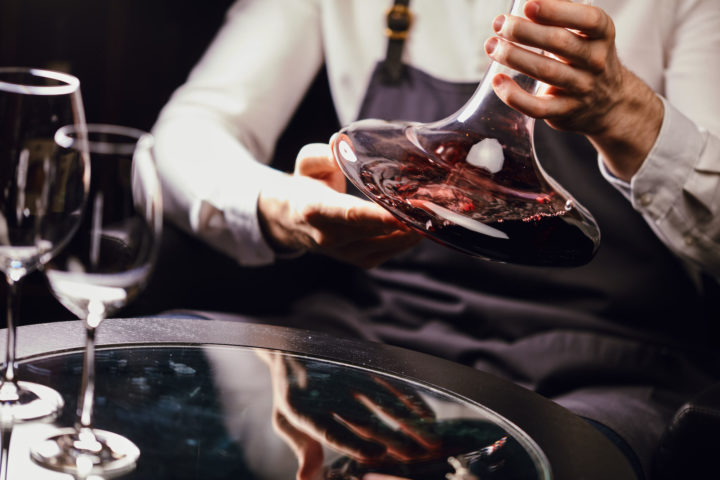
Decant / carafe wine and let it breathe
Total Time: 28 minutes
Choose the right carafe
A wide carafe with a large surface area is best for strong red wines, while a narrower carafe with a narrow neck is better for fine white wines.
Open wine bottle
Remove the tinfoil cap and the cork from the bottle and clean the neck of the bottle with a clean cloth.
Pour wine into carafe
Insert the neck of the bottle into the carafe and place it horizontally so that the wine pours out of the bottle with as much momentum as possible and oxygenates itself. If your carafe has a special attachment or funnel, be sure to use it. It ensures that the wine flows down the outside of the carafe and thus has the largest possible surface area.
Swivel carafe
After all the wine has been moved to the decanter, swirl the decanter a few times to expose the wine to the pleasure.
Let wine breathe
Then close the carafe and let the wine breathe for 30 minutes to 4 hours. If you’re not sure how long you want your wine to breathe, you can taste periodically and watch it evolve.
Supply:
- Wein
Tools:
- Karaffe, Kellnermesser, Tuch,
Decant the wine and separate it from the deposit: Step by step
- Prepare the wine: If you store your bottles lying down, you should put them upright for a few hours (better days) before decanting so that the deposit collects at the bottom of the bottle.
- Choose the right decanter: Choose an appropriate decanter for the type of wine you want to decant. A small decanter with a narrow, angled neck is well suited for highly aged and therefore delicate red wines.
- Prepare the table: Place a clean cloth or towel on the table to catch any drips. You will also need a light source, such as a candle, flashlight, or smartphone, so that you can see the sediment in time as you decant it.
- Open the bottle: remove the foil and the cork. Wipe the neck of the bottle with a clean cloth to remove dust and dirt and prevent it from getting into the wine.
- Decant slowly: Hold your decanter at a 45° angle and place the neck of the wine bottle against the lip of the decanter. Pour the wine slowly and evenly into the decanter.
- Avoid sediment: Make sure that no suspended matter from the bottle enters the vessel. Once you see the sediment slowly approaching the neck of the wine bottle, stop pouring. With a light source shining through the neck of the bottle, you can detect the sediment in time.
- Let the wine rest: After the wine has been decanted, give it a reasonable amount of time to rest before serving. This allows it to breathe and develop its full aroma and flavor.
How long must wine decant? The optimal time for different types of wine
How long a wine needs to breathe depends on the type and age of the wine in question. Here are some practical pointers to help you determine the correct decanting time:
- Young red wines (< 5 years): 1-4 hours
- Mature red wines (5 to 10 years old): 30 minutes to 1 hour
- aged red wines (10+ years old): up to 30 minutes
- White wines: 15 to 20 minutes. However, as a rule, not necessary.
Keep in mind that these guidelines are not set in stone and the optimal time for decanting varies by wine. It is therefore advisable to take a trial sip at regular intervals to determine when it has reached its full potential.
Popular decanters and carafes for every budget
Want to add a touch of elegance to your dining table? Then you’ll be thrilled with the most popular decanters and carafes the market has to offer. From traditional designs to modern creations, there is something for everyone.
| Preview | Product | Price | |
|---|---|---|---|
|
|
Leonardo Cheers Ecco Dekanter, 1,3 l, Höhe 22,5 cm, handgefertigtes Klarglas, 027810* | 33,42 EUR | Bei Amazon kaufen* |
|
|
RIEDEL Black Tie Amadeo Dekanter, Einzelpackung, klares+schwarzes Kristallglas, handgefertigt* | 285,00 EUR 247,90 EUR | Bei Amazon kaufen* |
|
|
Zalto Karaffe DENKART No150* | 79,90 EUR | Bei Amazon kaufen* |
|
|
Zalto Denk’Art Dekanter Axis* | 98,90 EUR | Bei Amazon kaufen* |
Preis inkl. MwSt., ggf. zzgl. Versandkosten / Letzte Aktualisierung am 2025-07-09 / Affiliate Links / Bildquelle: Amazon Product Advertising API
The art of decanting: how and why to decant?
This is where science and art meet. You have to know why you decant and, above all, how to do it right. A beautiful decanter enhances the drinking experience and can leave a lasting impression on your friends. When choosing a carafe, pay attention to its style, size and material. Crystal decanters are especially popular because they look classy and reflect the light in the room, adding a touch of class to any event.
Decanting can also be a little show in itself. Sommeliers often use big, dramatic movements during this process, adding a theatrical touch.
Decant aged wines vs. young drops
Whether or not a wine should be aerated depends largely on the age of the wine. Especially young wines with a high tannin content benefit greatly from aeration. Decanting makes the tannins more velvety and the wine develops its complex bouquet and flavor. For older wines, on the other hand, aeration is not so important, as they have already developed significantly in the bottle. However, decanting is worthwhile even with older wines to free the wine from any sediment that may have settled in the bottle.
Care should be taken with older wines, as they are sensitive to oxygen and may be damaged as a result. Therefore, pour the wine only slowly and carefully to reduce the risk of severe oxidation and to preserve the subtle flavors and aromas of the wine.
3 myths about decanting debunked
Myth 1: All wines must be decanted
Fact: Many wines benefit from decanting, but not all wines require it. Light white and rosé wines usually do not need this, as they have less (rosé) or no (white) tannins and hardly form any sediment. Also, some older wines may be too delicate to aerate and are best enjoyed straight from the bottle.
Myth 2: Decanting is only for expensive wines
Fact: Decanting affects the aroma and taste of wines regardless of their price category. Less expensive wines can also benefit from this, as aeration softens coarse tannins and allows the wine to develop its full potential.
Myth 3: The longer you carafe, the better
Fact: While it is true that some wines benefit from a longer decanting time, it is possible to overdo it. Excessive aeration can lead to excessive oxidation and loss of the delicate notes and flavors of the wine. Therefore, it is important to observe the wine during aeration and adjust the duration accordingly.
Caraffing for white wines?
Although red wines in particular should be aerated, some white wines can also benefit. Full-bodied white wines, such as the mature Chardonnay, thus develop a more complex overall picture, just like their red relatives. Older white wines with tartar can also benefit from decanting to achieve a clear and visually pleasing overall appearance.
It should be noted that white wines usually require a much shorter aeration time. For most white wines, a duration of 30 minutes to one hour is quite sufficient.
By the way, some sommeliers and winemakers swear by letting sparkling wines breathe, too, to better bring out their subtle notes and soften a coarse perlage somewhat.
Frequently asked questions
Which wines must be decanted?
On the one hand, older red wines are decanted to separate the clear wine from the deposit, which precipitates during storage and accumulates at the bottom of the bottle. On the other hand, young and tannic reds are aerated to soften their tannins and bring out the fine wine aromas.
How to decant / carafe wine?
This depends on whether an old red wine is to be separated from its deposit or a young Cabernet Sauvignon is to be aerated. The former is done by carefully and slowly decanting the wine into the narrowest possible vessel. In the latter case, the wine is poured into a wide carafe, preferably with a lot of oxygen contact, and sometimes aerated for several hours.
How long do you have to decant wine?
This depends very much on the type of wine. Young, tannin-rich red wines require several hours, while older reds may remain in the carafe for a maximum of 30 minutes to avoid damage. Large, full-bodied white wines maximum 30 minutes.
Why is wine decanted?
Decanting has several reasons. First, it is to remove the deposit, which is especially necessary for older red wines. Secondly, it improves the taste of wine by allowing it to breathe (carafe) and exposing it to the air. In this way, the tannins become more velvety and the different aromas and flavors emerge.
What is decanting wine called in English?
The English translation for “decant wine” is “to decant wine”.
Conclusion
Decanting is an important operation for all wine lovers who want to enhance their enjoyment experience. If you understand the purpose of decanting, know the optimal times for different types of wine, and get the myths surrounding decanting right, you can take your wine enjoyment to a new level. So the next time you open a bottle of wine, remember to decant it to unlock its full potential and create a memorable experience for you and your guests. Cheers!




